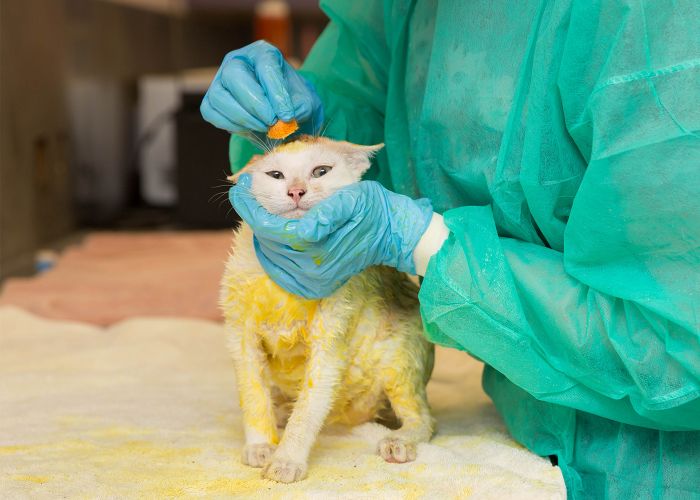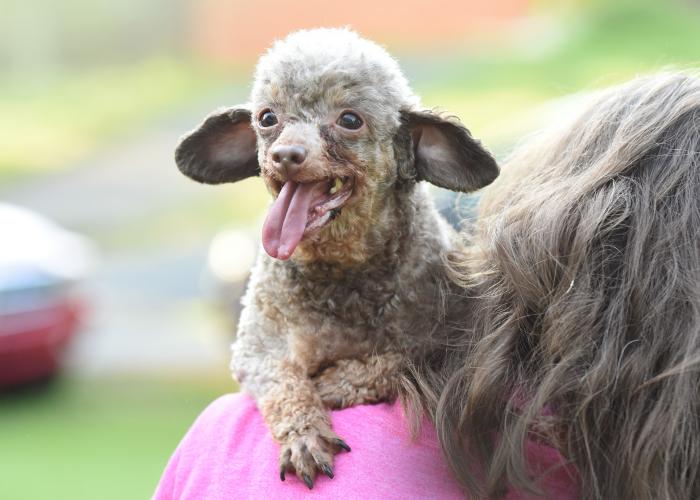The dark side of the coop
For shelters and rescues taking in chickens, the quest for backyard eggs isn’t all it’s cracked up to be

"We have three chickens,” reads the email, one of many that routinely land in Mary Britton Clouse’s inbox. “Somehow they all got frostbitten when they were a couple months old. One is missing every claw, one is missing feet, and [one] is missing feet and shanks. We were wondering if you guys could take them in.”
Britton Clouse is the president and founder of Chicken Run Rescue in the Minneapolis-St. Paul metro area. Currently housing 65 birds, plus more in foster homes, Chicken Run recently moved to a publicly undisclosed location—partly to gain space for its growing flock of rescued birds, and partly to prevent people from dumping birds at the property.
It’s the “locavores,” says Britton Clouse. The philosophy that eating locally produced food is healthier and tastier, boosts the local economy, benefits the environment and supports small, free-range farms has led some to the logical conclusion that backyard chicken coops are a better alternative to factory farms.
It’s easy to see their point: Large-scale operations do confine chickens to cruelly small or crowded spaces, painfully cut off beak ends, drop live male chicks into high-speed grinders and gas hens once they’re past their laying prime. In contrast, a backyard chicken coop seems idyllic, the “de rigueur symbol of suburban simplicity,” according to The New York Times. If farmhouse style guru Joanna Gaines’ cult following and the explosion of Mason-jar Pinterest crafts, rustic furnishings and barn weddings are any indicator, we’re all just one burlap-covered pillow away from becoming free-range farmers.
This pastoral fantasy—and perhaps the recession, which may have prompted people to form more self-reliant food networks à la World War II victory gardens—has fueled the emergence of a backyard chicken movement. These days, groups around the country are pushing for city ordinances that allow backyard coops, arguing that the birds contribute to a sustainable lifestyle (an argument contested by some scientists and food experts). Advocates say that chickens eat kitchen scraps and pests and provide fertilizer from the other end, all while making possible backyard-to-table omelets.
There's no denying that well-kept backyard chickens live better lives than factory-farmed hens. But backyard eggs aren’t necessarily guilt-free—and shelters, rescues and sanctuaries shoulder the fallout when things go wrong.

Ruffling feathers
“I’ve heard people refer to ‘waiting for this fad to end,’ but I don’t think it will,” says Justin Van Kleeck, president of farm animal sanctuary Triangle Chance for All in Chapel Hill, North Carolina. “Unless the USDA or the FDA really cracks down on it, which I don’t see happening, I don’t see the backyard chicken phenomenon slowing down any time soon.”
In fact, the backyard chicken movement continues to grow despite legislative efforts to curb it. Chicago’s City Council tried and failed to ban chickens in 2007, and in 2017, Washington, D.C.’s mayor pulled a bill that would have banned backyard chickens, thanks to a grassroots movement calling for her to “Lay off the hens.” In May 2017, the Texas Senate passed a bill that bans cities from … banning backyard chickens.
Lawmakers are overwhelmed by backyard bird enthusiasm: In 2006, Minneapolis Animal Care and Control issued 37 coop permits; in 2016, it issued 214. Rent a Coop in Potomac, Maryland—one of many startups that rent out mobile coops and hens for month-long stints during the summer—was renting out five to six coops a month in 2012 and 25-30 coops a month by 2015. Backyard coops are now so run-of-the-mill that they’re sold at Walmart, Williams-Sonoma, Target and Petco.
On the flip side, Chicken Run was asked to take in roughly four chickens a month in 2006 and 30 chickens a month by 2016. Farm Sanctuary in Watkins Glen, New York, was asked to take in around 12 chickens a month prior to 2009, but in the first five months of 2017, it was asked to take in an average of 99 backyard chickens a month—including 160 in May alone, thanks to hatching season. And in 2016, the Centers for Disease Control and Prevention says it “saw the largest number of illnesses linked to contact with backyard poultry ever recorded”—eight separate outbreaks of human salmonella infections, affecting 895 people from 48 states.
“I’ve heard people refer to ‘waiting for this fad to end,’ but I don’t think it will.”
—Justin Van Kleeck, Triangle Chance for All
In an effort to improve flock care and prevent surrender and abandonment, Minneapolis added a chicken-keeping class requirement for coop permit holders in 2016, says Casper Hill, media relations coordinator for the city. Several other cities also require training for backyard keepers, and Austin, Texas (which is considered backyard coop central), provides free classes. Where cities don’t enforce or encourage education, farm supply stores and experienced keepers often pick up the slack, offering classes to anyone with a backyard and a taste for fresh eggs.
Yet some keepers are still providing subpar care due to widespread misinformation. Online backyard chicken forums discuss chicken ailments, advise dubious home remedies and suggest “green” ideas, like composting dog feces to make chicken feed. Popular backyard chicken sites describe chickens as “the very definition of low maintenance,” provide flawed instructions on using the “deep litter” method to keep chickens warm through winter and advise amateurs on “especially cold-hardy” breeds.
In Minneapolis, where professionals flock to the thriving job market and affordable housing, this idealism crashes up against the state’s brutally cold winters. Chickens are descended from tropical red jungle fowl and thrive in warm climates, like the Hawaiian island of Kauai, where wild chickens are as common as pigeons. During a Minnesota winter, the average overnight temperature is around 4 degrees. Those who practice the deep litter method allow fecal matter and straw to decompose on the bottom of the coop, theoretically generating heat as it composts. When the method is practiced improperly, “the birds become parasite infested, freeze and live in their own excrement,” says Britton Clouse, who regularly takes in chickens with frostbitten toes, feet and combs.
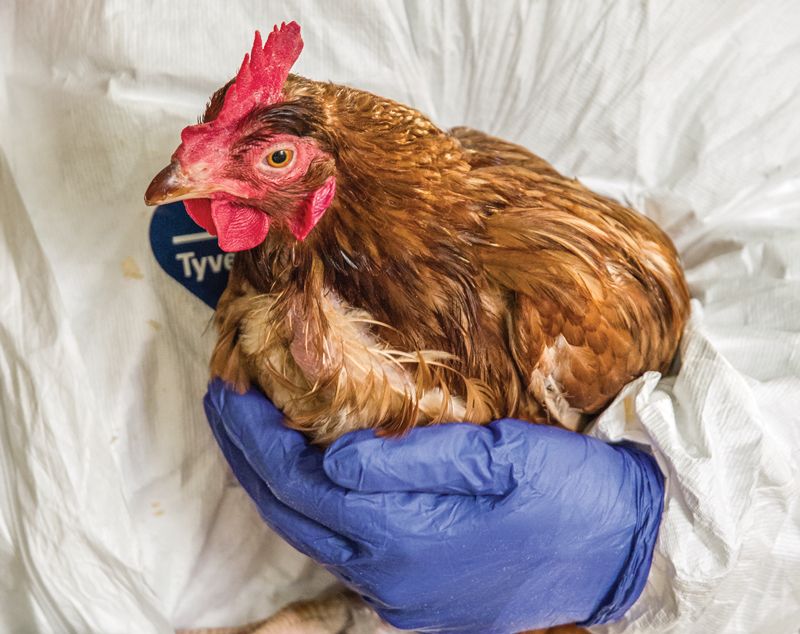
Not quite sticking it to the man
Most hobbyists buy chicks or fertilized eggs at feed stores or online, where you can buy five live chicks—shipped to your home in a box—for just $5.45. Chicks and eggs come from large-scale hatcheries that supply factory and hobby farms, and the ratio of hens to roosters people receive is a crapshoot.
On a backyard chicken forum, people post hatchery recommendations and gripes. “I’ve gotten multiple orders from them. They are always great about refunding you or shipping you more chicks if any die within 48 hours from when you pick them [up],” says one keeper.
“Just be aware that you may end up with packing material i.e. a whole bunch of male chicks put in there for warmth,” warns another.
“We had a shipment of 15 rare breed pullets hatched Monday ... After a lot of calls and helpful local postal employees, I tracked them down at a sorting facility Wednesday afternoon. All dead,” someone else chimes in.
“Of course we hate it when chicks die along the way,” explains a site that ships chicks for around a dollar each, but goes on to portray such deaths as the cost of doing business, pointing out that factories, farms and feed stores get chicks the same way. Chicks are going to die in the production of eggs, the site argues, no matter where the eggs come from.
“The birds become parasite infested, freeze and live in their own excrement.”
—Mary Britton Clouse, Chicken Run Rescue
“People think they’re doing something noble and sustainable by raising birds in their backyards, but they’re supporting the very same industry that’s supplying the major producers,” says Britton Clouse. “For the most part, they’re all coming out of a fairly small cross-section of hatcheries.” Someone recently surrendered a hen, originally purchased at a feed store that sourced her from a hatchery, with severely deformed legs due to spotty incubation.
“[People] don’t realize what these hatcheries are like,” adds Kelly Mullins, animal care director at Catskill Animal Sanctuary in Saugerties, New York. The sanctuary houses around 175 chickens surrendered from backyard coops and rescued from factory farms, school hatching projects, tenant farms and even meth labs, where they’re used to mask the smell. “Whether it’s a puppy mill or a hatchery,” Mullins says, “when you buy an animal, you are supporting that industry.”
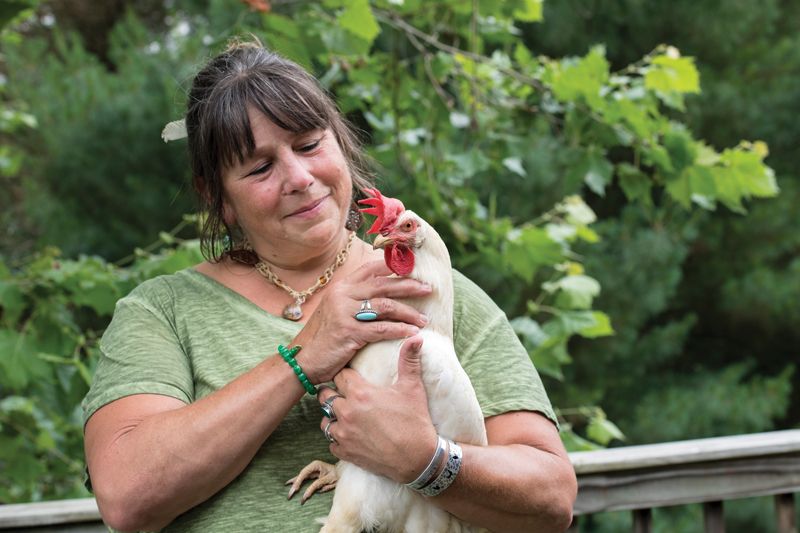
Pecking order
In your average backyard coop, hens are most often raised for eggs and only occasionally for meat. This leaves little place in the coop for roosters, especially when many city ordinances allow only female chickens, says Sara Shields, animal behavior and welfare scientist for Humane Society International’s farm animals division.
Once chicks grow into chickens, people often find they have more roosters than they expected (read: they often didn’t want or expect any at all). Even in cities that allow them, roosters don’t always get along with each other—and there’s also the early morning crowing.
“These little chicks come packed in boxes, and many die en route and they also are missexed, so somebody thinks they’re getting five hens and they really end up with three roosters and two hens,” says Mullins, who receives calls about taking in roosters every day but refers people to other sanctuaries due to lack of space. “Then all those roosters end up either dumped somewhere or people are desperate to try to find them a home, and sanctuaries like ours end up completely just filled beyond capacity with roosters.”
“I actually sometimes feel like I’m working in a hospice center, just trying to keep the hens as comfortable and happy as I can for as long as I can.”
—Sherstin Rosenberg, Happy Hen Chicken Rescue
“We get contacted about roosters all the time, every single day, and we can’t take them all, because you can only have a certain amount of roosters per hen,” says Zoe Rosenberg, the 11-year-old founder of Happy Hen Chicken Rescue in San Luis Obispo, California. The sanctuary has so many roosters that the birds are assigned day shifts and night shifts for the outdoor space. Backyard chicken keeping has “just really exploded, and we don’t have the infrastructure to back it up, to rescue all of these animals that are now unwanted,” adds Sherstin Rosenberg, Happy Hen veterinarian (and Zoe’s mom).
A search for “rooster” on the Minneapolis Craigslist page pulls up around 80 listings, minus the rooster-themed pottery and yard ornaments. “Free, Red Rock Rooster,” reads one. “Yes he would be good eatin.” “All I want is to keep my 5 hens,” writes a keeper who bought chicks from a flock that wasn’t sexed before sale. “Rooster wakes up at 6 otherwise we would keep him to protect our hens, sheriff said he needs to stay quiet till 7 so out he goes,” says yet another. Judging by Craigslist, people are trying to give away roosters all over the country: in New York and Baltimore, Boston and Chicago, Detroit and Dallas.
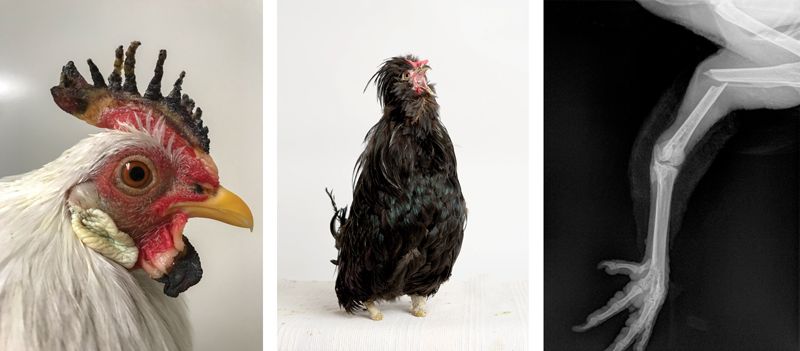
Sick of eggs
Today’s egg-laying hens have been bred to lay around 300 eggs a year. That’s a far cluck from egg-laying hens a century ago, who laid around 100 eggs a year, and wild chickens, who lay around 12.
The high-volume laying means hens often develop reproductive cancers or egg yolk peritonitis (the wearing out of the reproductive tract), at which point farms typically cull the birds, and backyard keepers may need to shell out for expensive veterinary care. “It’s like an old tire; the tissue just disintegrates,” Britton Clouse says, adding that she uses hormonal implants, which must be replaced every six to eight months, to cease her flock’s laying. (The solution isn’t affordable for many sanctuaries.)
Ironically, some people who purchase egg-laying hens eventually develop such an attachment to the birds that “they’re disgusted by the idea of eating their eggs,” says Britton Clouse. “So they continue to buy eggs from the store.” As a matter of principle, Chicken Run and other rescues don’t eat or sell their flocks’ eggs, but feed them back to the birds to supply the calcium that’s depleted during egg laying.
Sherstin necropsies all of Happy Hen’s chickens after death. More than 90 percent of hens “die of reproductive issues,” around age 3, she says, while roosters live on, exacerbating the rooster overpopulation problem. She brings ailing hens into the sanctuary’s intensive care unit for treatment. Because people often don’t see chickens as being “worth” veterinary care and surrender them when they get sick, “I actually sometimes feel like I’m working in a hospice center, just trying to keep the hens as comfortable and happy as I can for as long as I can,” she says.
“The vast majority of hens will end up with some kind of reproductive issue,” says Mullins, with an individual’s life expectancy depending on a combination of breed and luck. Four years ago, Catskill took in 200 hens from an egg factory; today, only one survives, she says. (Living to the ripe old age of 16, the oldest recorded domesticated hen spent her life indoors and never laid an egg, according to her owners. Although estimates vary, wild chickens can live to around 25 years old.)
The shortened lifespan of a hen can get even shorter when you factor in predators: Backyard keepers are often surprised to find their yard transformed into something like the set of a horror movie.
Chickens will attract “raccoons, dogs, coyotes, fox, mink, opossum, rats, owls, bobcats, hawks, snakes, weasels, ferrets, fishers, marten and humans,” says Britton Clouse, recommending sturdy locks and privacy fencing.
“Chickens have special needs with regard to being protected from predators, and there are so many cases where people get chickens and they don’t last because something will get them,” says Shields. “Even with some pretty sturdy coops, if they’re hungry, they will get in there.”

Coming home to roost
Situated between the suburbs of D.C. and rural farmland, Fairfax County Animal Shelter in Virginia has taken in 29 chickens over four months. Although the county itself doesn’t allow people to keep backyard chickens without two acres of land or a special permit, the shelter takes in a steady supply of strays and surrenders.
“There’s a surprising number of stray chickens,” says Amanda Novotny, communications and outreach manager. Then there are the dropoffs from a local “chicken man” who collects chicks from elementary school hatching projects and brings any he can’t place in homes to the shelter. There was the box of chicks left on someone’s porch as a dubious practical joke, and the six chicks a father gifted to his children, who live in an apartment with his former wife.
In Fairfax County, at least, chicken adopters aren’t too difficult to find. Neighboring counties allow backyard birds, and hens are usually adopted out in under a week, while roosters take about a month to find a new perch. Adoptions and intake counselor Ray Long adopted one of those roosters, Ricky, in February and added three hens in March. “She can talk your ear off literally 24 hours [a day] about how much she loves that rooster,” says Novotny. “He is gorgeous—the most handsome rooster ever.”
“I’ve always liked chickens,” says Long, but it wasn’t until she adopted her own flock that she discovered their individual personalities. “There’s something about them,” she says. “They’re smart, they’re funny, they’re interactive. They keep me outside all the time. I look forward to seeing them in the mornings. I couldn’t care less if they never laid an egg”—though she says co-workers and friends love receiving the little gifts.
Fairfax County added a small barn equipped for chickens when the shelter was renovated in 2013, but other shelters aren’t so broody. In North Carolina, where an antiquated law requires shelters to hold stray farm animals for 10 days and then put them up for public auction, rather than adoption, “we try to be there to help take some of the burden off the shelters,” says Van Kleeck of Triangle Chance for All. “Every time I go to pick up a rooster from a shelter, they’re like, ‘Thank God!’” Some shelter staffers simply don’t know how to handle farm animals, but others also find themselves fending off “adopters” who want to eat the animals, he says. Shelters in the state “are all so overworked with the dog and cat situation. To then start throwing things like chickens at them?”
“I couldn’t care less if they never laid an egg. ... Ever since I’ve had these chickens, I’ve been happier.”
—Ray Long, Fairfax County Animal Shelter
Van Kleeck and his wife, Rosemary, were involved in dog and cat rescue before stumbling upon a goat at a shelter, which prompted them to adopt hens Amandine and Clementine in 2014. “It was a matter of luck that we became aware of the problem of farm animals in shelters, and that led us to rethink our whole understanding of what sanctuaries are,” he says. “Even if we didn’t have hundreds of acres, we could still provide a sanctuary for them and others.”
The result was the Van Kleecks’ Microsanctuary Movement and a growing network of microsanctuaries, which can house as few as one or two farm animals. (Because microsanctuary owners don’t eat the birds or eggs, Van Kleeck uses the word “farm” in air quotes.) “Almost all of our residents have come from a backyard chicken situation,” he says. “That phenomenon alone has overwhelmed our sanctuary and most of the sanctuaries we know.”
The couple cares for around 35 roosters and 30 hens and is called on to catch stray chickens several times a month. Often, cities pass ordinances allowing backyard coops but don’t add funding to their animal control budgets, says Britton Clouse, meaning animal control might not get around to a stray bird for several days and neglected coops go unnoticed. She and her husband, Bert, keep a “to-go kit” on hand for instances when people call and say animal control can’t send someone out for a stray chicken.
“Lots of those,” she says with a laugh. “Lots of traipsing around in the dark in people’s backyards with nets and flashlights and carriers.”
Triangle Chance for All, Chicken Run and Happy Hen only adopt out chickens to people who won’t eat the birds or eggs. (Catskill doesn’t currently adopt out chickens at all, fearing the outcomes.) “Chickens are so companionable; they love attention. They make excellent pets,” says Sherstin with Happy Hen. “Ultimately, you’re relying on that person, and I think that’s what shelters do with cats and dogs, as well. They’re relying on people having integrity and being honest.”
Fairfax County, on the other wing, practices open adoptions and follows up with adopters after a few weeks. No adopter has ever returned a chicken to the shelter.
“It’s the same as any other pet, on paper, at least, but we do a lot of verbal counseling with people to make sure that they are actually prepared. … Usually when people are coming in to adopt chickens, they’re so excited that they’re able to help a homeless chicken that they’re also simultaneously showing us pictures of all their other chickens,” says Novotny. “It’s part of the counseling process to make sure we’re not adopting someone their dinner.”
Shields acknowledges that “there’s always this balance between trusting that people are going to take care of the animals and not having enough homes for them all.” As the most common domestic animal in the world, even if chickens were simply pets, “there would still be so many chickens in need of homes, forever,” adds Mullins. “There’s no way that we’re going to run out of chickens.”
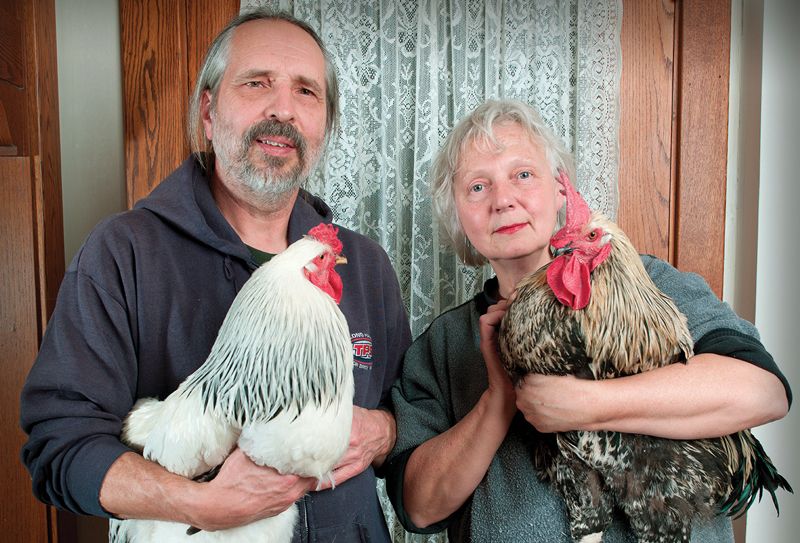
Foreseeing this never-ending tide of homeless birds, Britton Clouse and her husband hired a chicken caretaker who they hoped would keep Chicken Run clucking along when they couldn’t—the couple is in their 60s—but they amicably parted ways after nine months. “It’s always been just Bert and [me],” says Britton Clouse. Together, they’ve rescued over 1,000 birds. “The work is too hard emotionally, mentally and physically for most people.”
The past year has been difficult. Relocating to a larger site and a new home, a move that included 50 chickens, “really just about killed us,” she says. Chicken Run was previously housed in “inner city” Minneapolis on just one-tenth of an acre. It was bittersweet to leave their old home behind.
“We had a lot of [neighbors] who were really down on their luck, nothing happy happening in their lives except for the fact that there [was] this really cool chicken place where they take in animals,” she says. “Everybody was proud to have us in their neighborhood.” Despite having as many as 19 roosters at once, Britton Clouse says Chicken Run never received a single complaint in 16 years.
With a rescue at capacity, and after a grueling move and the loss of an additional caretaker, the couple still has hope for the future. They plan to use the extra space to host visiting speakers, artists and veterinary interns and focus on teaching others how to rescue and care for birds. Plus, “we have wonderful, experienced and trusted volunteers,” Britton Clouse says, and they’ve recently been overwhelmed by others who want to volunteer and foster—including their previous home’s new owner.
“He wanted to keep the good vibes that the property had absorbed after all those years,” she says. “Chicken Run is going to survive beyond our grip.”



